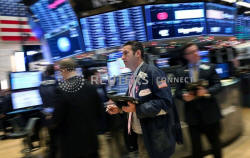Buying and holding volatility usually hurts; then came
2018
 Send a link to a friend
Send a link to a friend
 [December 26, 2018]
By Saqib Iqbal Ahmed [December 26, 2018]
By Saqib Iqbal Ahmed
NEW YORK (Reuters) - The big uptick in
stock market gyrations this year has made a surprise winner out of a
trade that has rarely delivered a win - buying and holding volatility.
Stock market ructions over the last decade have been few and fleeting,
requiring great feats of timing to generate profits from volatility
buying.
Not so this year.
Frequent bursts of market gyrations have kept things lively in the
volatility space and has made betting on enduring turmoil hugely
profitable.
While the S&P 500 <.SPX> is getting crushed to a degree not seen since
the financial crisis a decade ago - the index is down 19 percent in the
last three months - a trader who took a flyer on volatility early this
year could be pocketing a profit of 70 percent or more.
"The thing that worked in the volatility space this year is the thing
that almost never works - just buy and hold volatility," said Matt
Thompson, co-head of commodity trading adviser Typhon Capital Plc's
volatility group in Chicago.

Since volatility usually rises when stocks fall, owning volatility is a
form of insurance and just like any other insurance there is a cost
attached to it.
"Usually it costs a lot to own volatility," said Jim Carney, chief
executive officer at New York-based hedge fund Parplus Partners.
Most volatility instruments, including options, futures and
exchange-traded notes (ETNs), lose value rapidly when stocks are calm or
rising.
But with the stock market in the grips of almost daily wild swings, for
the first time in years it has paid to own volatility, said Carney.
One example of how well that trade has worked is the iPath S&P 500 VIX
Short-Term Futures ETN <VXX.P>, which is up about 72 percent this year.
The ETN tracks the performance of the Cboe Volatility Index <.VIX>, a
widely followed options-based barometer of expected near-term volatility
for stocks.
VXX follows an index that tracks the price of two near-term VIX futures
and seeks to maintain a constant one-month exposure to volatility by
repeatedly selling first-month futures to buy second-month contracts.
"When the front month VIX future is below the second month there's a
huge cost to owning the product, but now with the front month around the
same level of the second month, or above it, there is no cost," said
Carney.
Under normal conditions, first-month VIX futures are priced lower than
second-month contracts as uncertainty about how stocks will fare leads
traders to boost the volatility embedded in further-out expirations.
That is a problem for VXX, which essentially is constantly selling the
relatively cheaper first-month contract and buying the more expensive
second-month contract.
[to top of second column] |

Traders work on the floor of the New York Stock Exchange (NYSE) in
New York, U.S., December 11, 2018. REUTERS/Brendan McDermid

This constant erosion in value has caused VXX to hemorrhage money like few other
products. A $100,000 invested in VXX at its inception in 2009 would be worth
about $40 now.
But during times of market stress, such as now, first-month contracts become
even more pricy than contracts with expirations further out. That gives VXX a
fillip.
The VXX is on pace this year to finish up for the first time in its decade-long
existence.
OMINOUS PORTENT
VXX's success this year bodes ill for the overall stock market. While the ETN
has only been around since 2009, estimating how the index might have fared in
previous years paints a bleak picture for the near-term outlook for U.S. stocks.
"It wasn't trading then, but 2007 and 2008 would have been up years," said Vance
Harwood, who runs the alternative investment website Six Figure Investing and
has studied VIX products extensively.
Harwood estimates that VXX would have gained about 40 percent in 2007 and more
than doubled in price in 2008, as the stock market got hit by the global
financial crisis.
Others also see the similarity.
"This year looks a lot like 2007," said Typhon's Thompson.
"I am not predicting a 2008 next year but we had a pretty fundamental transition
this year from the old low volatility regime to the new higher volatility
regime," Thompson said.
Regardless of whether VXX's strong performance is a portent of trouble for
stocks next year, higher levels of daily stock gyrations should draw more
investors to the ETN, analysts said.
"With volatility in the 20s for the VIX, I think it is an excellent product to
be long," said Parplus' Carney.

Presently, more than 50 million VXX shares change hands every day and the ETN
has about $800 million in assets under management.
"I wouldn't be surprised to see it bump up into the $1 billion to $1.5 billion
range," said Harwood.
(Reporting by Saqib Iqbal Ahmed in New York; Editing by Jeffrey Benkoe)
[© 2018 Thomson Reuters. All rights
reserved.] Copyright 2018 Reuters. All rights reserved. This material may not be published,
broadcast, rewritten or redistributed.
Thompson Reuters is solely responsible for this content. |